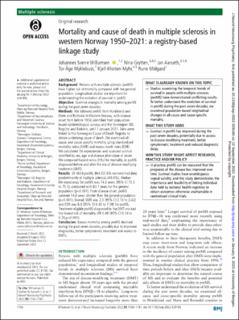| dc.contributor.author | Willumsen, Johannes Sverre | |
| dc.contributor.author | Grytten, Nina | |
| dc.contributor.author | Aarseth, Jan Harald | |
| dc.contributor.author | Myklebust, Tor Åge | |
| dc.contributor.author | Myhr, Kjell-Morten | |
| dc.contributor.author | Midgard, Rune | |
| dc.date.accessioned | 2023-01-10T13:26:44Z | |
| dc.date.available | 2023-01-10T13:26:44Z | |
| dc.date.created | 2022-12-01T12:30:21Z | |
| dc.date.issued | 2022 | |
| dc.identifier.issn | 0022-3050 | |
| dc.identifier.uri | https://hdl.handle.net/11250/3042385 | |
| dc.description.abstract | Background Persons with multiple sclerosis (pwMS) have higher risk of mortality compared with the general population. Longitudinal studies are important for understanding the evolution of survival in pwMS.
Objective Examine changes in mortality among pwMS during the past seven decades.
Methods We followed pwMS from Hordaland and Møre and Romsdal in Western Norway, with disease onset from before 1950, identified from population-based epidemiological surveys and the Norwegian MS Registry and Biobank, until 1 January 2021. Data were linked to the Norwegian Cause of Death Registry to obtain underlying cause of death. We examined all-cause, and cause-specific mortality using standardised mortality ratios (SMR) and excess death rates (EDR). We calculated life expectancies and assessed survival stratified by sex, age and disease phenotype at onset. We compared hazard ratios (HRs) for mortality, in pwMS diagnosed before and after the era of disease-modifying treatment (DMT).
Results Of 3624 pwMS, 964 (55.5% women) had died, predominantly of multiple sclerosis (49.0%). Median life expectancy for pwMS was 74.3 years (95% CI 73.3 to 75.3), compared with 83.1 years for the general population (p<0.001). From disease onset, pwMS survived 14.6 years shorter than the general population (p<0.001). Overall, SMR was 2.3 (95% CI 2.13 to 2.42) and EDR was 6.8 (95% CI 6.42 to 7.09) for pwMS. Treatment-eligible pwMS diagnosed in the DMT era had the lowest risk of mortality, HR 0.49 (95% CI 0.34 to 0.70,p<0.001).
Conclusion Excess mortality among pwMS declined during the past seven decades, possibly due to improved diagnostics, better symptomatic treatment and access to DMTs. | en_US |
| dc.language.iso | eng | en_US |
| dc.publisher | BMJ | en_US |
| dc.rights | Navngivelse-Ikkekommersiell 4.0 Internasjonal | * |
| dc.rights.uri | http://creativecommons.org/licenses/by-nc/4.0/deed.no | * |
| dc.title | Mortality and cause of death in multiple sclerosis in western Norway 1950-2021: A registry-based linkage study | en_US |
| dc.type | Journal article | en_US |
| dc.type | Peer reviewed | en_US |
| dc.description.version | publishedVersion | en_US |
| dc.rights.holder | Copyright 2022 The Author(s) | en_US |
| cristin.ispublished | true | |
| cristin.fulltext | original | |
| cristin.qualitycode | 2 | |
| dc.identifier.doi | 10.1136/jnnp-2022-329169 | |
| dc.identifier.cristin | 2086992 | |
| dc.source.journal | Journal of Neurology, Neurosurgery and Psychiatry | en_US |
| dc.source.pagenumber | 1154-1161 | en_US |
| dc.identifier.citation | Journal of Neurology, Neurosurgery and Psychiatry. 2022, 93 (11), 1154-1161. | en_US |
| dc.source.volume | 93 | en_US |
| dc.source.issue | 11 | en_US |

